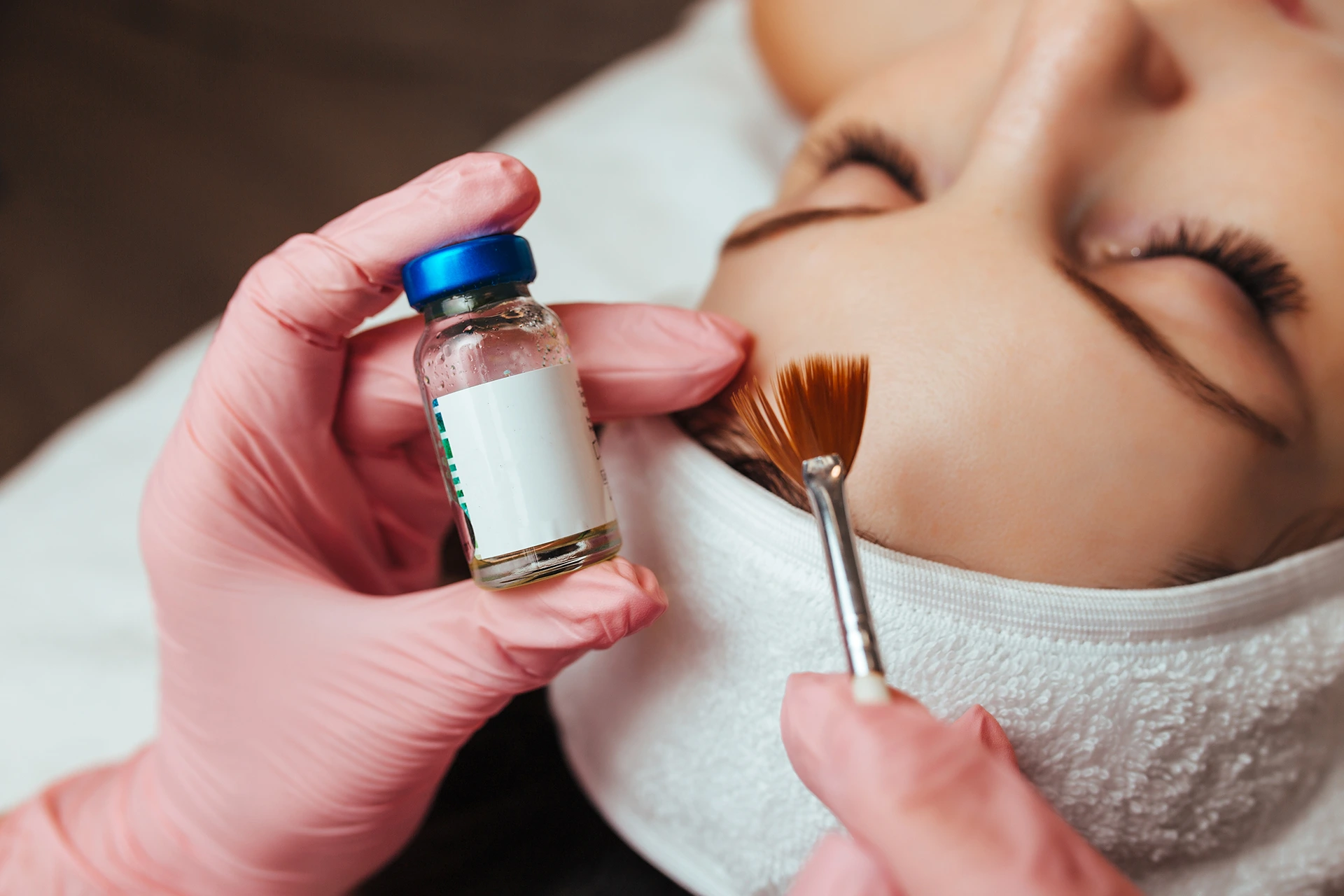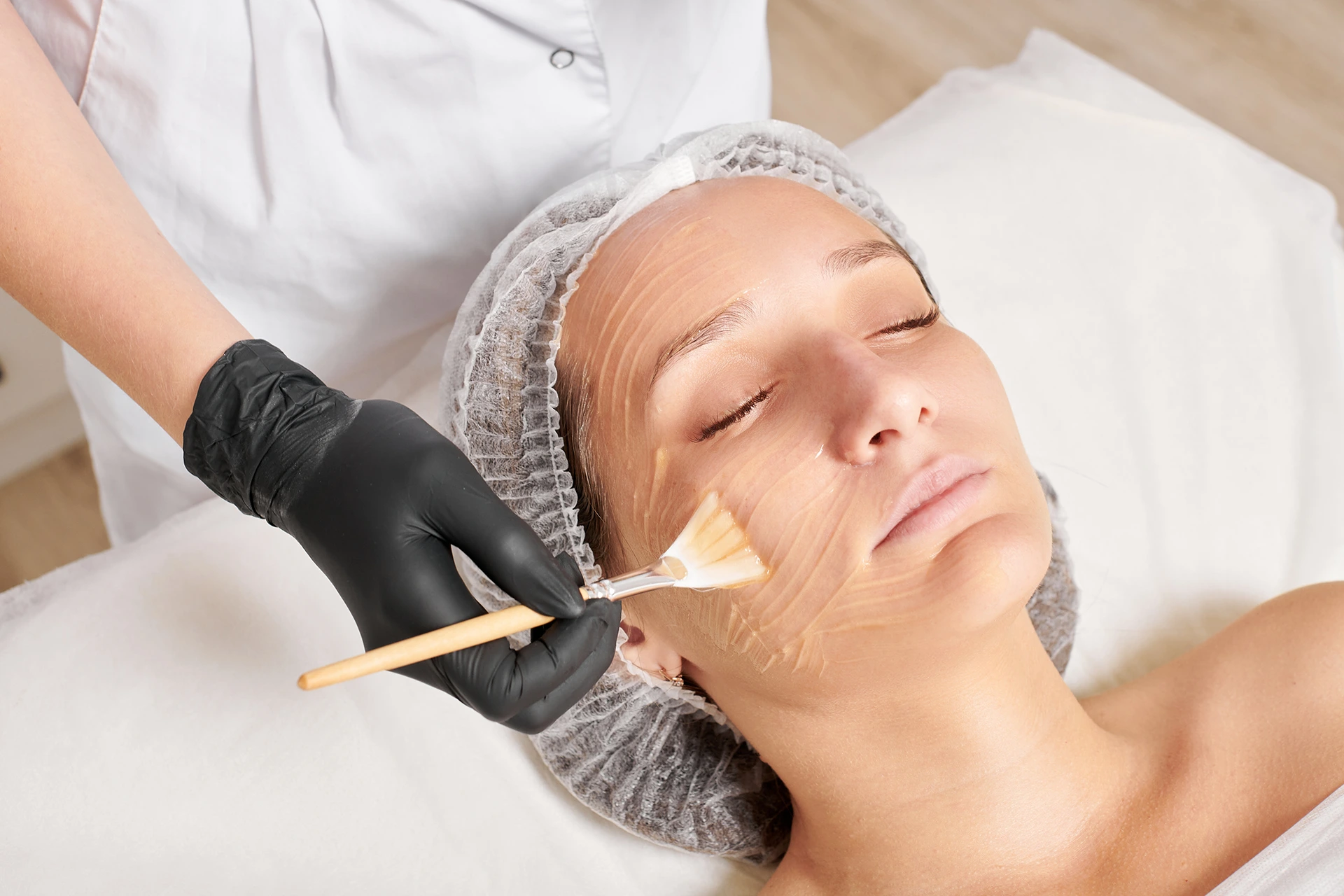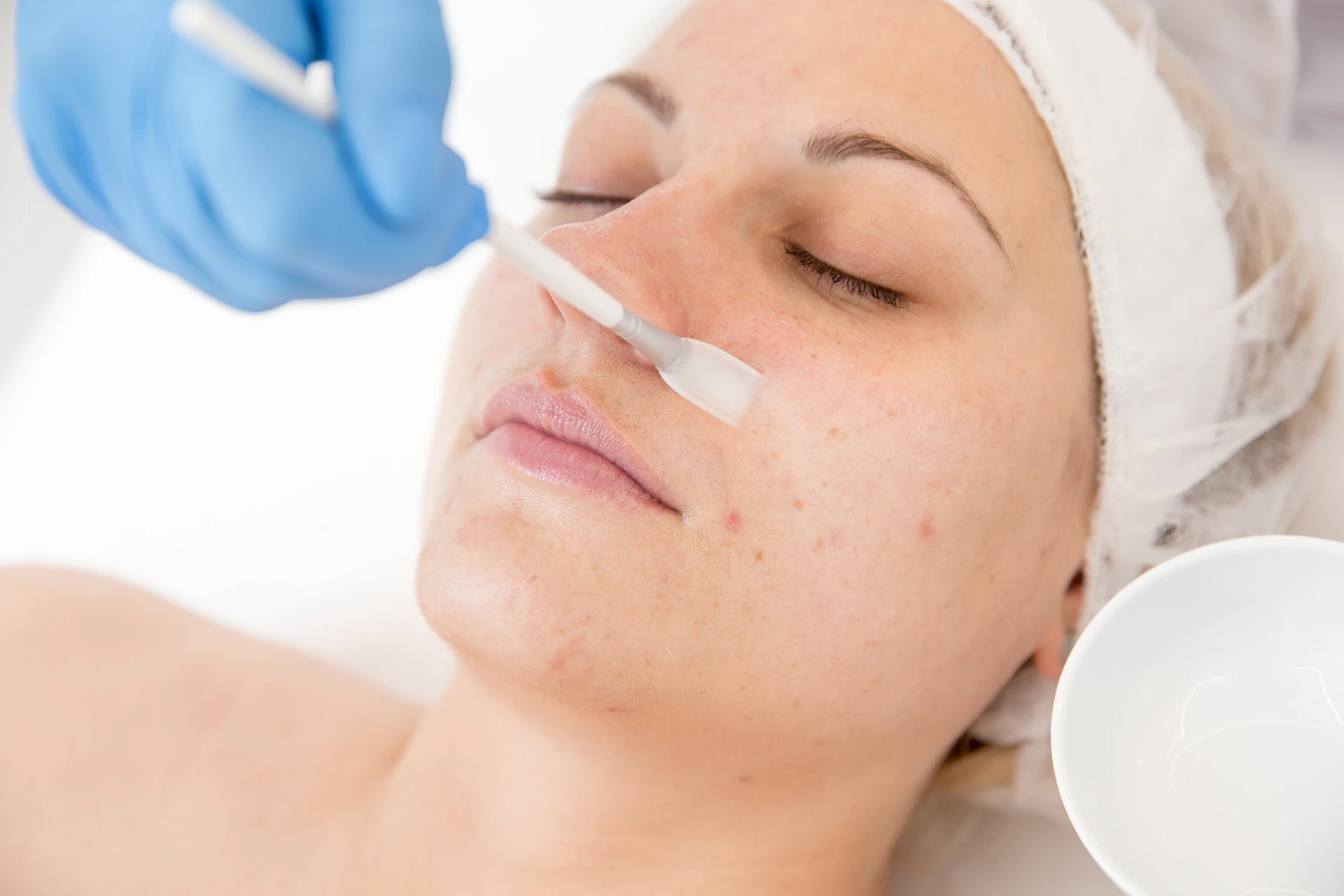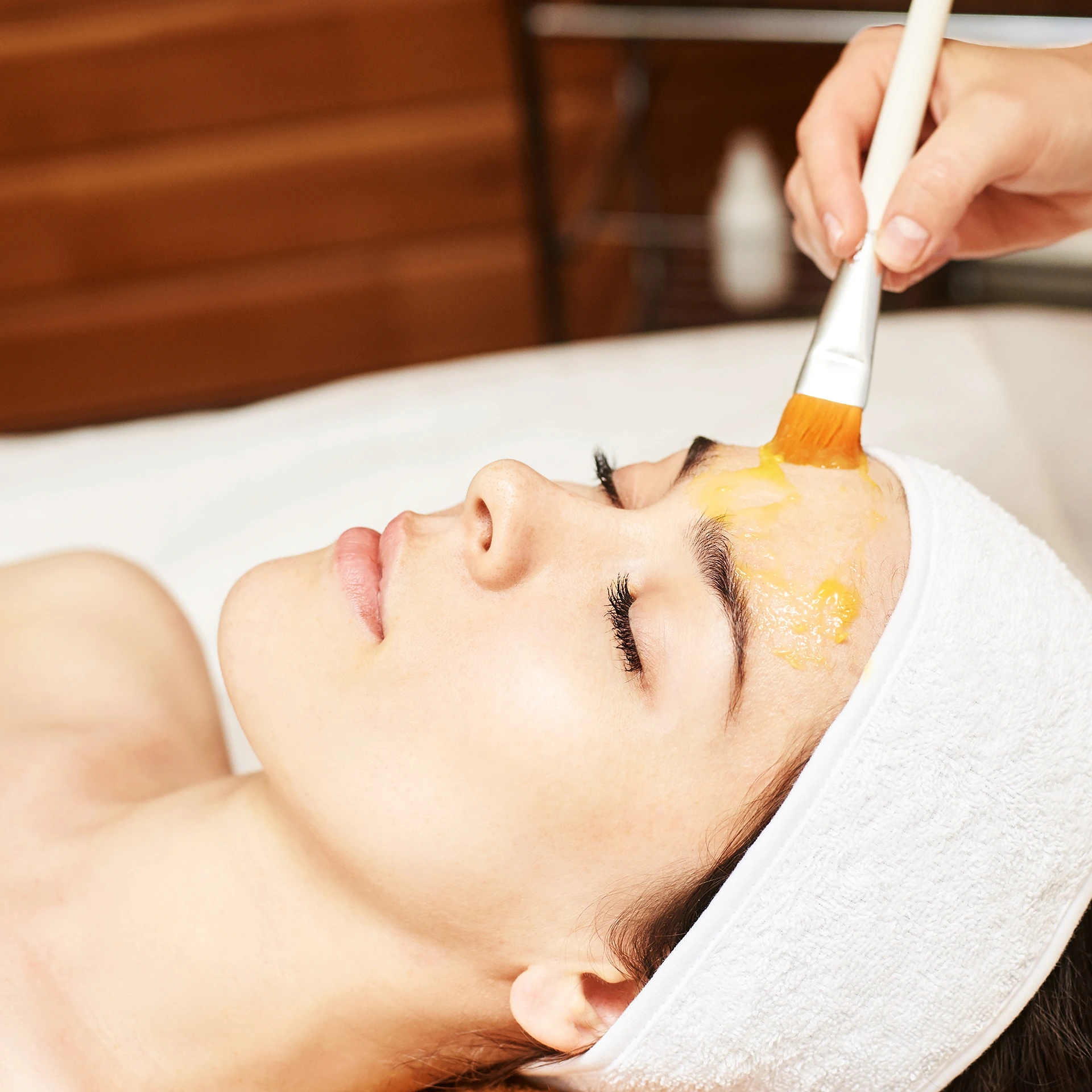Reveal Your Radiance: Unveiling the Remarkable Benefits of Chemical Peels
Chemical peels have been used for centuries to rejuvenate and revitalize the skin. From Cleopatra’s milk and honey facials to today’s advanced chemical peel techniques, this treatment has stood the test of time for good reason.
Chemical peels offer a range of benefits, from improving skin texture and reducing the appearance of wrinkles to treating acne and minimizing hyperpigmentation. Whether you’re looking to refresh your complexion or address specific skin concerns, a chemical peel may be just the solution you need. In this article, we’ll explore the many benefits of chemical peels and why this treatment should be on your beauty radar.
What Is a Chemical Peel?
A chemical peel is a cosmetic treatment that involves applying a chemical solution to the skin to remove its topmost layer. This process promotes the growth of new, healthier skin cells and improves overall skin texture, tone, and color.
Chemical peels come in different types and strengths, from light peels that target superficial scars and sun spots to deeper peels that address more severe skin concerns such as acne scarring and deep wrinkles.
Despite their varying intensities, chemical peels are highly effective in treating a wide range of skin issues and are a popular choice among people looking to enhance their skin’s appearance. In the following sections, we’ll explore the many benefits of chemical peels in more detail.
Benefits of Chemical Peels
Chemical peels are a highly versatile and effective cosmetic treatment that can offer a wide range of benefits for the skin. Depending on the type and strength of the peel, it can target specific skin concerns such as acne scars, dark spots, and uneven skin tone. However, regardless of the type of peel, all chemical peels have benefits that can make a world of difference on the skin.
Superficial peels, for instance, can restore and rejuvenate the skin, making it look more youthful and radiant. These gentle peels work by removing the top layer of dead skin cells, which can help to unclog pores and reduce the appearance of fine lines and wrinkles. By resurfacing the skin, superficial peels also allow for better absorption of skincare products, which can enhance their effectiveness and improve overall skin health.
Another key benefit of chemical peels is that they can boost collagen production, which is essential for healthy, firm skin. Collagen is a protein that gives skin its structure and elasticity, but its production declines naturally as we age. By stimulating collagen production, chemical peels can help to firm and tighten the skin, reducing the appearance of sagging, wrinkles, and fine lines.
Chemical peels can also boost radiance and improve overall skin texture and tone. By removing the outer layer of dead skin cells, peels allow for the growth of new, healthy skin cells, which can improve skin health and give it a more youthful glow.
Overall, the benefits of chemical peels are numerous and varied, making them an excellent choice for anyone looking to improve their skin’s appearance and health. Whether you’re struggling with acne scars, dark spots, or simply want to boost radiance, a chemical peel can help you achieve smoother, firmer, and more youthful-looking skin.
Types of Chemical Peels
Chemical peels come in different types and strengths, each designed to address specific skin concerns and issues. Superficial peels, also known as light peels, are the mildest type of chemical peels and are ideal for people with mild skin concerns such as acne scars, dark spots and fine lines.
Medium depth peels, on the other hand, are stronger and penetrate deeper into the skin. They are effective in treating deeper scars and wrinkles.
Finally, deep chemical peels are the strongest and can provide significant improvement for more severe skin conditions such as deep wrinkles and scars. It is important to consult with a trained professional to determine which type of chemical peel is suitable for your specific skin type and concerns.
Superficial Peels
Superficial peels, also known as light peels, are a popular cosmetic treatment designed to gently exfoliate the topmost layer of skin. AHAs (alpha hydroxy acids) and BHAs (beta hydroxy acids), such as glycolic acid and salicylic acid, are often used in low concentrations to remove dead skin cells, unclog pores, and improve skin texture and tone.
Unlike more intensive chemical peels, superficial peels do not penetrate deep into the skin, making them a safe and gentle option for most people.
Superficial peels are ideal for those looking to maintain a youthful appearance or improve minor skin issues such as dullness, uneven skin tone, and clogged pores. They are a quick and easy treatment that requires little to no downtime, allowing patients to return to their normal activities right away.
Because superficial peels only affect the top layer of skin, the healing period is usually short and mild, with minimal redness and peeling that typically lasts only a few days. However, it is important to talk to a trained professional to ensure you receive the right type of peel for your skin and concerns.
Overall, superficial peels are a highly effective way to achieve smoother, brighter skin and maintain a healthy and youthful appearance.
Medium Depth Peels
Medium-depth peels are a type of chemical peel that penetrate deeper into the skin’s layers than superficial, light peels. These peels are typically used to address more severe skin issues such as age spots, hyperpigmentation, and deeper scars. They can be an effective treatment option for those who may not see results from lighter peels or skincare products alone.
The chemicals typically used in medium-depth peels include glycolic acid and trichloroacetic acid (TCA) in higher concentrations. These acids work to remove the outermost layers of skin, stimulating collagen production and smoothing out the texture of the skin. Medium peels are designed to produce more noticeable results than superficial peels, but they also require a longer healing process.
After a medium-depth peel, the skin may appear red and swollen for several days. As the top layers of skin continue to exfoliate, there may also be some peeling and flaking. The healing process typically takes between one to two weeks, with the final result being softer, smoother, and more even-looking skin.
Medium-depth peels are ideal for specific skin concerns such as moderate sun damage, fine lines, and wrinkles. However, there are some risks associated with this type of chemical peel, including a higher risk of hyperpigmentation, especially for those with darker skin tones. It is important to discuss any medical history or skin sensitivities with a licensed professional before undergoing a medium-depth peel.
To get the best results from a medium-depth peel, proper skin preparation and aftercare are crucial. This may involve using specific skincare products or avoiding certain activities that could irritate the skin. Consulting with a licensed professional who can provide guidance on the appropriate treatment plan and aftercare routine is essential in achieving optimal results.
Deep Chemical Peels
Deep Chemical Peels are one of the more intense forms of chemical peel treatments. Unlike superficial or medium peels, they penetrate several layers of skin to address more severe issues such as deep scars or skin discolorations caused by sun damage or aging.
The process of a deep chemical peel typically involves the use of a chemical solution, such as high concentrations of trichloroacetic acid or phenol. The solution is applied to the skin and left for an extended period of time, typically 30 minutes or more, to allow it to fully penetrate the layers of skin. During this time, patients may experience some discomfort or burning sensations.
While deep chemical peels can produce dramatic and long-lasting results, they can also come with some potential side effects. These may include redness, swelling, and scabbing, which can take several weeks to fully heal. Patients may also experience prolonged sensitivity to light and a heightened risk of infection, which is why proper care is necessary both before and after the treatment.
Deep peels are particularly effective at improving severe discolorations and long-term scars. They work by stimulating collagen production, which helps to restore elasticity and firmness to the skin. Additionally, the deep penetration of the chemical solution helps to exfoliate and remove the damaged outer layers of skin, allowing newer, healthier skin cells to come to the surface.
To prepare for a deep chemical peel, patients should begin a skincare regimen several weeks prior to the treatment. This may involve the use of specific exfoliating agents or avoiding excessive sun exposure. After receiving the treatment, patients should follow specific post-care instructions, which may include avoiding strenuous exercise or excessive sun exposure, as well as using specific skincare products to promote healing.
Deep chemical peels typically require the administration of local anesthetics and offer a longer healing period compared to lighter forms of peels. During the healing period, patients should expect some discomfort, redness, and swelling. However, with proper preparation and aftercare, patients can expect smoother, more even-toned skin with improved elasticity and firmness.
Skin Conditions Treated with Chemical Peel Solutions
Chemical peels offer a multitude of benefits beyond just smoother, more even-toned skin. They can also be used to treat a variety of skin conditions, from acne scars to dark spots and cold sores. By promoting the growth of new, healthy skin cells and renewing the outer layer of skin, chemical peels can improve overall skin texture and appearance while addressing specific concerns such as scarring and discoloration caused by sun damage or aging. Learn more about the specific skin conditions that can be effectively treated with chemical peel solutions below.
Acne Scars and Other Scarring
Chemical peels have been shown to be an effective way of treating acne scars and other types of scarring. This is because chemical peels work by removing dead skin cells from the topmost layer of skin, which can help to reduce the appearance of scarring. Additionally, chemical peels can stimulate the production of new collagen fibers, which can help to fill in acne scars and improve the overall texture of the skin.
However, it’s important to note that the production of new collagen fibers can sometimes have unintended consequences when it comes to scarring. For example, if too much new collagen is produced, it can lead to hypertrophic scars (raised scars) or atrophic scars (depressed scars). This is why it’s important to choose the right type of chemical peel for your specific type of scarring.
When it comes to treating acne scars and other types of scarring, medium depth chemical peels are typically recommended. These peels are designed to penetrate deeper into the layers of the skin than superficial peels, but not as deep as deep chemical peels. This makes them an ideal choice for improving the appearance of scarring, as they are able to increase cell turnover and promote the growth of new collagen fibers.
Chemical peels can also help to reduce inflammation and kill bacteria on the surface of the skin. This can be beneficial for those dealing with acne scars, as inflammation and bacteria are often contributing factors in the development of acne.
Finally, one of the major benefits of chemical peels is that they can increase the absorption of topical treatments, such as skin creams or serums. This means that after undergoing a chemical peel, any topical treatments that you use will be able to penetrate deeper into the skin, where they can be more effective at treating scarring and other skin concerns.
Overall, chemical peels are a highly effective way of treating acne scars and other types of scarring. By exfoliating the top layer of skin and stimulating the production of new collagen fibers, these treatments can improve the appearance of scarring while promoting overall skin health and rejuvenation.
Uneven Skin Tone and Dark Spots
Uneven skin tone and dark spots are common skin concerns that can be addressed with the help of chemical peels. Chemical peels can lighten the skin and brighten its appearance, reducing the visibility of age spots, sun damage, and other types of hyperpigmentation.
Uneven skin tone and dark spots can be caused by various factors such as sun exposure, hormonal changes, and age. Sun exposure is a common culprit, resulting in dark spots and uneven skin tone due to damage caused by UV rays. Hormonal changes, such as those that occur during pregnancy or as a result of taking hormonal birth control, can also cause hyperpigmentation. And as we age, our skin’s natural ability to exfoliate decreases, causing dead skin cells to build up and leading to a dull, uneven complexion.
Getting regular chemical peel treatments can help improve the appearance of uneven skin tone and dark spots. Chemical peels work by removing the top layer of dead skin cells, revealing fresh, healthy skin underneath. This helps to reduce the appearance of hyperpigmentation and age spots, while also promoting collagen production for smoother, firmer skin. In addition, regular chemical peel treatments can help to prevent the buildup of dead skin cells and reduce the appearance of fine lines and wrinkles.
Chemical peels can be tailored to meet the specific needs of each individual. Superficial and light peels are ideal for those who want to brighten their skin tone and improve its texture, while deep chemical peels are better suited for those with more severe hyperpigmentation concerns. Trichloroacetic acid (TCA) and glycolic acid are common solutions used in chemical peels to combat uneven skin tone and dark spots.
Overall, chemical peels are an effective way to improve the appearance of uneven skin tone and dark spots. By removing dead skin cells and stimulating collagen production, chemical peels can lighten the skin and brighten its appearance, restoring a youthful, even complexion.
Age Spots, Freckles and Sun Damage
Chemical peels are a popular cosmetic treatment that can benefit individuals looking to address age spots, freckles, and sun damage. These conditions are commonly caused by prolonged exposure to harmful UV rays, which can lead to hyper-pigmentation of the skin.
Hyper-pigmentation refers to the darkening of skin due to an excess of the pigment melanin. Melanin production increases in response to prolonged exposure to UV radiation, which is why age spots and freckles typically appear on areas that receive the most sun exposure, such as the face, hands, and arms.
Using chemical peels can help repair sun damage and minimize hyper-pigmentation. By removing the damaged outer layer of skin, chemical peels reveal fresh, healthy skin underneath. In addition to visibly reducing fine lines and wrinkles, chemical peels can plump and tighten skin, resulting in a more youthful and rejuvenated appearance.
Including this information in the section is crucial because age spots, freckles, and sun damage are common skin concerns that can affect individuals of all skin types. Chemical peels offer a safe and effective solution for those looking to address hyper-pigmentation and achieve smoother, more even skin.
Don’t let age spots and freckles diminish your confidence. Schedule a chemical peel treatment today and say goodbye to sun damage and hyper-pigmentation.
Smoother Skin Texture
Chemical peels can work wonders in improving the texture of your skin. If you are battling with rough, dry or uneven skin, a chemical peel can be an effective way to enhance the appearance of your skin.
Chemical peels gently exfoliate your skin, removing dead skin cells, which can create a buildup that makes your skin appear dull and uneven. By targeting the topmost layer of your skin, chemical peels can help reduce the appearance of fine lines and wrinkles, resulting in smoother skin.
Another great benefit of chemical peels is that they can boost the effectiveness of your anti-aging skincare routine. By removing the outer layer of dull and damaged skin, fresh and rejuvenated skin is revealed, which is better equipped to absorb the nourishing ingredients of your skincare products. This means that regular chemical peels can help you get the most out of your anti-aging products and reveal smoother, brighter skin.
Chemical peels are also great for reducing the appearance of hyperpigmentation and skin discolorations, resulting in a more even and radiant skin tone. Active ingredients used in chemical peels, such as glycolic acid, lactic acid, and salicylic acid, are specifically formulated to penetrate deeper layers of your skin, which can further improve its texture and promote collagen production, leading to firmer and more youthful-looking skin.
Incorporating regular chemical peels into your skincare regimen can help you achieve a smoother skin texture, reduce the appearance of fine lines and wrinkles, and even out your skin tone. By choosing a chemical peel that is right for your skin type and concerns, you can achieve healthy and glowing skin in no time.
Cold Sores
When considering chemical peel treatments, it’s important to take into account any pre-existing skin concerns, including a history of cold sores. Cold sores are a common and often reoccurring skin condition that can be triggered by a variety of factors, including stress, illness, and certain skincare treatments.
If you are someone who is predisposed to experiencing cold sores, it is important to inform your aesthetician prior to receiving a chemical peel treatment. This will allow them to take necessary precautions and provide you with the best possible care.
It is generally recommended for individuals with a history of cold sores to take an antiviral medication prior to receiving a chemical peel. This can help prevent a potential outbreak and ensure the best possible results. In addition to taking antiviral medication, adhering to after-care instructions is also crucial for avoiding further irritation to the skin and minimizing the risk of a cold sore outbreak.
By being proactive and mindful of any pre-existing skin concerns, such as a history of cold sores, you can still enjoy the benefits of chemical peel treatments with minimal risk of irritating flare-ups. Remember to communicate with your aesthetician, take preventative measures, and follow after-care instructions to ensure the best possible results.
Layer of Skin Renewal and Growth of New Cells
Chemical peels are an effective way to promote Layer of Skin Renewal, which can rejuvenate the skin and reduce the appearance of wrinkles and fine lines. The process involves applying a chemical solution to the skin, which triggers controlled injury to the outermost layer of skin, thus dissolving it.
As the top layer of skin is dissolved, new, fresh skin cells start to grow, leading to Growth of New Cells that replace dull and damaged skin. This process of resurfacing the skin also activates the production of collagen and elastin fibers, which are essential for maintaining skin’s youthful appearance.
Collagen is a protein that provides skin with structural strength and support, while elastin is responsible for maintaining the skin’s elasticity. When the chemical solution activates the production of these fibers, it results in firmer and smoother skin, with fewer wrinkles and fine lines.
By targeting Layer of Skin Renewal and Growth of New Cells, chemical peels can improve the texture and tone of the skin. Additionally, collagen and elastin Production helps to improve overall skin health and slow down the aging process.
So if you are looking for a treatment that rejuvenates the skin and promotes the growth of new cells, then chemical peels may be worth considering. Incorporating this treatment into your skincare routine can help you achieve a more youthful appearance and healthier-looking skin.
Remember to discuss with your skin care professional what type of chemical peel is best suited for your skin type.
Common Active Ingredients Used in Chemical Peels

Alpha Hydroxy Acids (AHAs) are a group of naturally occurring acids found in fruits, milk, and sugar cane. These acids are commonly used in a variety of cosmetic products, including chemical peels, due to their excellent exfoliating properties.
AHAs work by targeting the topmost layer of the skin, dissolving and removing dead skin cells, and promoting the growth of new ones. They are frequently used in superficial peels to treat a variety of skin conditions such as age spots, uneven skin tone, and dry skin. Some of the most commonly used AHAs in chemical peels include glycolic acid and lactic acid. These ingredients are safe to use and have little to no downtime, making them suitable for those seeking a quick and effective solution for their skin concerns.
Alpha Hydroxy Acids (AHAs)
Alpha Hydroxy Acids (AHAs) are essential active ingredients used in chemical peels that have proven immensely beneficial in improving the appearance and texture of skin. These water-soluble acids work by exfoliating the skin and increasing collagen production, leading to smoother, younger-looking skin.
Glycolic acid, derived from sugar, is one of the most common types of AHA used in chemical peels. It works by penetrating deep into the skin, dissolving dead skin cells and revealing a brighter complexion. Glycolic acid is particularly effective at reducing fine lines and wrinkles.
Lactic acid, derived from milk, is another AHA frequently used in chemical peels. It has a larger molecule size than glycolic acid, making it gentler on the skin. Lactic acid is ideal for individuals with more sensitive skin. It also helps to improve the skin’s texture by dissolving dead skin cells and stimulating collagen production.
Citric acid is a third type of AHA commonly used in chemical peels. This acid is derived from citrus fruits and has antioxidant properties, making it an effective treatment for hyperpigmentation and uneven skin tone.
All these AHAs work by gently dissolving dead skin cells on the outermost layer of the skin, revealing a brighter, smoother complexion. By doing so, they stimulate the production of collagen, which helps to smooth out fine lines and wrinkles and improve skin firmness.
FAQ Section: Chemical Peel Benefits
Q: What are the benefits of a chemical peel?
A: Chemical peels offer several benefits for the skin. They help improve skin texture and tone, reduce the appearance of fine lines and wrinkles, diminish acne scars and hyperpigmentation, and stimulate collagen production. Chemical peels can also unclog pores, enhance the effectiveness of skincare products, and promote a smoother, rejuvenated complexion.
Q: Is a chemical peel good for skin?
A: Yes, a chemical peel is generally considered beneficial for the skin. It can address various skin concerns, such as acne, sun damage, uneven skin tone, and signs of aging. By exfoliating the outermost layers of the skin, a chemical peel encourages cell turnover and promotes a healthier, more radiant complexion.
Q: Does a chemical peel improve your skin?
A: Absolutely. A chemical peel can significantly improve the condition and appearance of your skin. It works by removing damaged skin cells and stimulating the production of new collagen and elastin fibers, which leads to smoother, firmer, and more youthful-looking skin. With regular treatments, a chemical peel can help improve skin texture, reduce wrinkles, fade scars, and even out skin tone.
Q: What are the benefits of facial peels?
A: Facial peels offer a range of benefits for the skin. They can help reduce the appearance of fine lines and wrinkles, diminish age spots and sun damage, improve acne-prone skin, and refine skin texture. Facial peels also promote a brighter complexion, minimize the appearance of pores, and enhance the absorption of skincare products.
Q: What are the advantages of chemical peels?
A: Chemical peels have several advantages when it comes to skincare. They are highly effective in addressing various skin concerns, such as uneven skin tone, acne scars, and fine lines. Chemical peels are customizable to different skin types and can be adjusted to achieve the desired level of exfoliation. Additionally, they are relatively quick procedures with minimal downtime, allowing individuals to resume their regular activities soon after treatment.
Q: What are the benefits of a chemical peel on the face?
A: A chemical peel on the face can provide numerous benefits. It can improve skin tone and texture, reduce the appearance of fine lines and wrinkles, fade age spots and sun damage, and promote a smoother, more radiant complexion. Chemical peels can also help treat acne and acne scars, minimize pore size, and rejuvenate dull or aging skin.
Q: What are the benefits of a skin peel?
A: Skin peels, also known as chemical peels, offer a range of benefits for the skin. They can help address various skin issues such as acne, hyperpigmentation, and uneven skin tone. Skin peels promote cellular turnover, resulting in a fresher, more youthful appearance. They also stimulate collagen production, improve skin texture, and contribute to a more even complexion.
Q: What are the benefits of using chemical peels?
A: Using chemical peels as part of your skincare routine can provide several benefits. They can help exfoliate the skin, remove dead skin cells, and unclog pores, resulting in a smoother, brighter complexion. Chemical peels also enhance the absorption of other skincare products, allowing them to work more effectively. Additionally, regular use of chemical peels can help improve skin tone, reduce the appearance of fine lines, and promote a healthier overall complexion.
Q: What are skin peels good for?
A: Skin peels are beneficial for various skin concerns. They can help improve the appearance of acne-prone skin, reduce the visibility of acne scars, lighten hyperpigmentation and dark spots, and even out skin tone. Skin peels also promote skin cell turnover, resulting in a fresher, more youthful complexion.
Experience the Benefits of Chemical Peels at CosMedic LaserMD
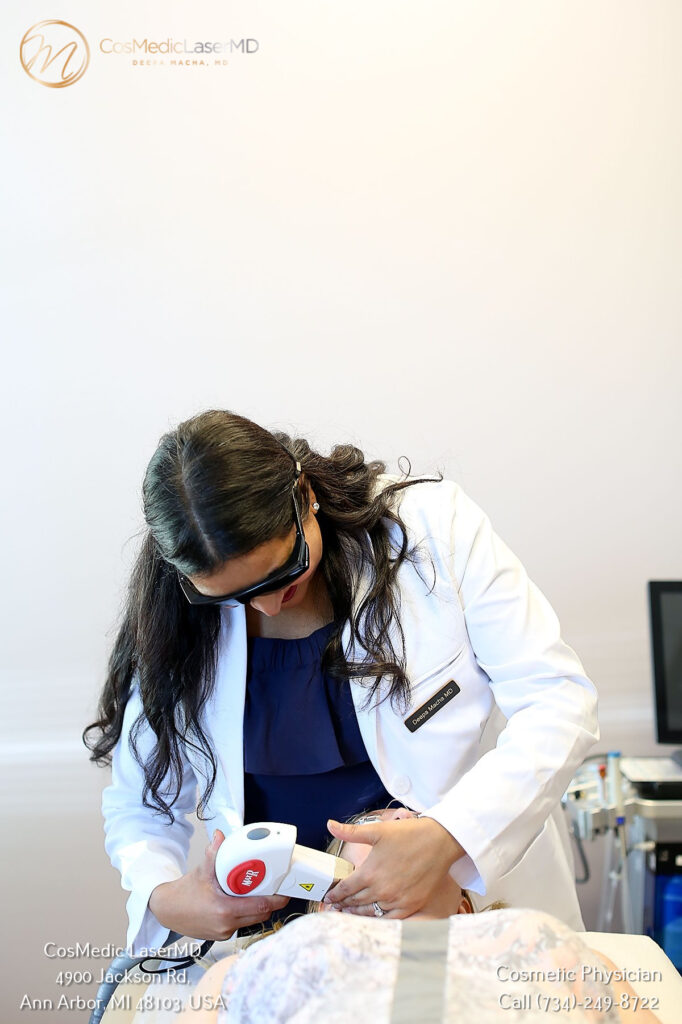
Chemical peels are a highly effective treatment option for anyone looking to achieve a brighter, smoother, and more youthful complexion. With a variety of strengths and formulations available, there is a chemical peel that can be tailored to your individual needs and concerns.
While it is important to seek out a qualified and experienced professional to perform the treatment, the benefits of a chemical peel are well worth the investment. So if you’re ready to step up your skincare game, consider adding a chemical peel to your routine and reap the rewards of healthier, more radiant skin. Contact us today to learn more!




